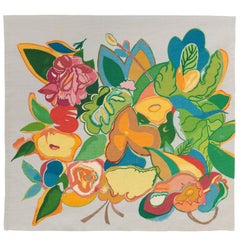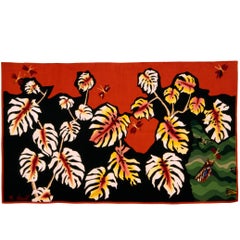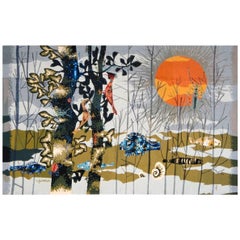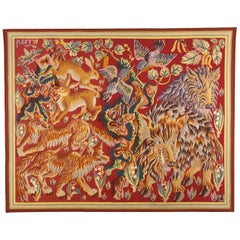Want more images or videos?
Request additional images or videos from the seller
1 of 2
Alexander Calder Tapestry
About the Item
Designed by Alexander Calder
Woven at Ateliers Pinton - Aubusson
- Dimensions:Height: 64 in (162.56 cm)Width: 107 in (271.78 cm)
- Place of Origin:
- Period:
- Date of Manufacture:circa 1970's
- Condition:
- Seller Location:New York, NY
- Reference Number:1stDibs: U08110285502
About the Seller
5.0
Recognized Seller
These prestigious sellers are industry leaders and represent the highest echelon for item quality and design.
1stDibs seller since 2008
9 sales on 1stDibs
Associations
The Art and Antique Dealers League of AmericaAntiques Associations Members
Authenticity Guarantee
In the unlikely event there’s an issue with an item’s authenticity, contact us within 1 year for a full refund. DetailsMoney-Back Guarantee
If your item is not as described, is damaged in transit, or does not arrive, contact us within 7 days for a full refund. Details24-Hour Cancellation
You have a 24-hour grace period in which to reconsider your purchase, with no questions asked.Vetted Professional Sellers
Our world-class sellers must adhere to strict standards for service and quality, maintaining the integrity of our listings.Price-Match Guarantee
If you find that a seller listed the same item for a lower price elsewhere, we’ll match it.Trusted Global Delivery
Our best-in-class carrier network provides specialized shipping options worldwide, including custom delivery.You May Also Like
Alexander Calder "The Waves" - French Wool Tapestry
By Alexander Calder
Located in New York, NY
- "Les Vagues" (The Waves) from the Bicentennial Tapestries series
- 41 x 59 in, 103 x 150 cm
- Signed by artist and monogrammed by atelier
- Numbered 39
- Atelier Pinton Frères in F...
Category
20th Century French Modern Tapestries
Materials
Wool, Silk
Pair of Modernist Tapestries after Robert Motherwell
By Robert Motherwell
Located in Atlanta, GA
Pair of Modernist needlepoint tapestries after Robert Motherwell, circa 1970s. They have been framed in clean lined black lacquer wood frames.
Category
Vintage 1970s American Mid-Century Modern Tapestries
Materials
Wool, Wood
Handwoven Tapestry, Hand dyed, geometric abstract wall hanging
By Andrew Boos
Located in Brooklyn, NY
This wall hanging is a one of a kind heirloom piece. Taking inspiration from brutalism, mid-century abstraction, and Joseph Albers studies on the interaction of color.
The entire pr...
Category
21st Century and Contemporary American Modern Tapestries
Materials
Wool, Cotton
Textile Poster, Contemporary Handwoven Tapestry by Andrew Boos
By Andrew Boos
Located in Brooklyn, NY
This wall hanging is a one of a kind heirloom piece, inspired by brutalism, and Joseph Albers studies on the interactions of colors.
The entire process of creating this wall hanging...
Category
21st Century and Contemporary American Modern Tapestries
Materials
Wool, Cotton
Textile Poster, Contemporary Handwoven Tapestry by Andrew Boos
By Andrew Boos
Located in Brooklyn, NY
This wall hanging is a one of a kind heirloom piece, inspired byFrank Lloyd Wright and the Prairie School architects, and Joseph Albers studies on colors.
The entire process of cre...
Category
21st Century and Contemporary American Modern Tapestries
Materials
Wool, Cotton
'Fleeting Moment', Abstract Handwoven Tapestry by Jo Barker
Located in London, GB
Fleeting moment is typical of Jo Barker’s intricate tapestries that explore the qualities and patterns of light. The deep inkiness of the brushstroke texture is dappled with flecks o...
Category
21st Century and Contemporary British Tapestries
Materials
Tapestry
'Fleeting Glimpse', Contemporary Abstract Tapestry by Jo Barker
Located in London, GB
The vibrancy of fleeting glimpse demonstrates Jo Barker’s deep understanding of color, tones and textures to create beautiful handwoven tapestries. Here, her use of color is challeng...
Category
21st Century and Contemporary British Contemporary Art
Materials
Tapestry
$16,366
H 65.75 in W 29.93 in D 1.19 in
'Float', Handwoven Contemporary Abstract Tapestry by Jo Barker
Located in London, GB
This stunning artwork by contemporary artist Jo Barker captures vibrant color and texture through painstaking handweaving technique. The ephemeral qualities of light are translated s...
Category
21st Century and Contemporary British Contemporary Art
Materials
Tapestry
Textile Poster, Contemporary Handwoven Tapestry by Andrew Boos
By Andrew Boos
Located in Brooklyn, NY
This wall hanging is a one of a kind heirloom piece. Taking inspiration from brutalism, mid-century abstraction, and Joseph Albers studies on the interaction of color.
The entire pr...
Category
21st Century and Contemporary American Modern Tapestries
Materials
Wool, Cotton
French Artist Charles Lapicque Tapestry Limited Edition 1/2 "Pelops", 1964
By Charles Lapicque
Located in Paris, France
Exceptional limited edition 1/2 tapestry "Pelops" with certificate from a private collection,
1964.
Ateliers Pinton brothers in Felletin, under the supervision of Pierre Baudouin
2ex + 1EA Editor Aram Iynedjian. The tapestry will be sold with its certificate of authenticity from the gallery.
From the 15th century, the name of Pinton was associated with the Aubusson tapestry. Since then, over the generations, the Pinton family has largely contributed to the development of this fabulous cultural heritage until the creation in the 19th century, of the Felletin factory, in the department of Creuse. Even today, in these workshops, the craftsmen execute the same correct gestures with the same attention to detail and thus extend the chain of the history of the tapestry of tradition but also contemporary. The hand of specialists, the eye of designers and dyers and the taste of the most demanding clientele find their meaning in the fabric of the carpets. The excellence of French know-how, a living heritage society and custodian of Aubusson's cultural heritage, has always collaborated with great artists. The works of Charles Le Brun, Charles Lapicque, Pablo Picasso, Jean-Michel Othoniel, and many other big names in the world of painting, architecture, design, fell into the looms and know-how ancestral of this unique Creuse creator.
Editor Aram Iynedjian
Aram Iynedjian, Lausanne gallery owner and editor of tapestries from Braque, Estève and Lapicque, the latter meets Pierre Baudouin, the most famous of the cardboard painters of the time. The one who translated the works of Le Corbusier, Calder or Picasso into tapestry then collaborates with Charles Lapicque and they will develop a work of great richness.
Lapicque came to realize these two summits which are "Pélops" and "Diane et Actéon".
I realize that you should never try to describe a work of art
Let’s look at it. Let us admire the science of composition, linear purity, technical perfection, the beauty of color, the truth of the drama. Let us see, if we can, the implacable presence of genius.
"We will now understand that after having based a painting on the love of tapestry, it was relatively easy, and very tempting, to build a tapestry faithful to my painting," explained the artist in the exhibition catalog. of the Galerie Verrière in 1970. It was not until 1961 that he began to produce cardboards both for the tapestry of the Lisse in Aubusson, but also at the Mobilier National, with the help of Pierre Baudouin
Charles Lapicque (1898-1988)
Born in 1898 in Theizé (Rhône) in a family practicing both the arts and the sciences, Charles Lapicque is no exception to the rule: gifted for music and drawing, he graduated from the École Centrale in 1921, works as engineer until 1928 before integrating in 1931 a laboratory at the Faculty of Sciences of Paris, where he carried out research on the perception of colors, crowned by the title of Doctor of Physical Sciences in 1938. He thus studies the reactions of the eye in front of an intense light source, at the origin of the formation of starry images which he will use in his works, and defines a theory of the staggering of colors in space which overturns the rules of the Renaissance: "I had shown that the Classic rule, that of Vinci, advocating placing the blues in the distance, the reds, oranges and yellows in the foreground, is
a nonsense; it makes more sense, more favorable to do the opposite. "(In Red and blue in the arts, 1936)
It was around 1920 that Charles Lapicque began to paint in Brittany where he spent every summer since his childhood, first on the motif and then in a workshop that his stepfather Jean Perrin, Nobel Prize in Physics, had him build in 1927 ; he then definitively adopted the work of memory, in accordance with the art of music which he deeply loved and the Bergsonian philosophy of knowledge: "It is up to us to give reality an appearance that it has no itself, a form, a figure (...). "
His youthful production immediately reveals a great originality, oscillating between figuration and abstraction which sometimes intertwine: alongside synthetic paintings by their simplified drawing and their flat colors, he designs an Homage to Palestrina (1925), composed of a grid derived from Cubism, entirely abstract, relayed by a Christ with Thorns (1939), according to a principle that he will develop after 1939, in line with his optical discoveries. In fact, during the war years, an almost abstract period began, that of the tight blue framework, applied to backgrounds ranging from yellow to red and revealing a more or less identifiable world (Jeanne d'Arc crossing the Loire, 1940; Rencontres series, 1940-1945). Exhibited in 1929 by the gallery owner Jeanne Bucher, Lapicque abandoned his scientific career in 1943 to devote himself entirely to painting.
He continued his work which resulted in 1946-1953 in white-frame structures; their much softer lines lead him to the system of
either black or white interlacing which encloses areas of pure color, most often in solid color. With The Battle of Waterloo in 1949, Lapicque still uses optics - zooming in on a given area - to depict spaces with multiple perspectives and decomposed times.
This new interest in the liveliness of color developed in the following period, which can be described as flamboyant or Baroque (1954-1963): illustrated in particular by the series of Breton lagoons and twilight or nocturnal views of Venice in the light. Stars, which the artist himself describes as “daring sweets”, it begins with the Raoul Dufy Prize of the Venice Biennale, awarded in 1953 to the artist who took the opportunity to give free rein to his passion for the Serenissima until July 1956.
Another point in common with his elder brother is the expression of movement. Begun in 1949 in The Battle of Waterloo then in 1952 with Dimanche aux regates, it became an obsession from 1964, in the exploration of new themes, such as the different shots of tennis players captured on the fly (1965), the mythological scenes and sea storms.
These dizzying years precede the artist's last period: as he comes of age, he discovers serenity, revealed by a painting now with acrylic paint, much more peaceful from 1974, which even borders on a childish naivety at the end. of his life.
All of his work includes an astonishing diversity of themes, also nourished by his travels (Rome in 1957, Greece in 1964, Holland in 1974 ...), with a predilection for the sea, rocks, sailboats, music, tennis, horses, wild beasts, but also for history and mythology, as evidenced by knights, kings and ancient gods. It also deploys, in total creative freedom, a wide variety of styles and orientations. Having been one of the pioneers of non-figurative art, thus paving the way for artists like Manessier, Bazaine, Vieira da Silva, De Staël, etc. Owners of the new non-figurative Paris School of the Postwar period, Charles Lapicque then returned to figuration, in a "new interpretation" of appearance, even if he continued to rub shoulders with abstraction at times.
"Drawing runs after color and color after drawing. "
Heir to the Fauves, Charles Lapicque plays like them on pure colors, whose dissonances, associated with a totally free design and an overloaded composition in a multiple space, make him a precursor of the New Figuration in all its forms: the Narrative Figuration born in France in the early 1960s, represented in particular by Gérard Fromanger, Erró, Bernard Rancillac and Gérard Guyomard; Free Figuration born in the early 1980s, marked by Robert Combas, Hervé and Richard Di Rosa, Louis Jammes and François Boisrond, and which, in turn, influenced the American Bad Painting of a Jean-Michel Basquiat or a Keith Haring, deliberately neglected and Expressionist; Lapicque's “Classic subjects” were able to feed Cultivated Painting, which also appeared in the early 1980s with Jean-Michel Alberola, Patrice Giorda and Gérard Garouste...
Category
Mid-20th Century European Tapestries
Materials
Wool
$42,652
H 86.62 in W 104.34 in D 0.2 in
More From This Seller
View AllRomare Bearden Aubusson Tapestry
By Romare Bearden
Located in New York, NY
Mid-Century tapestry designed by Romare Bearden (1911-1988) and woven at Atelier Pinton Freres in Aubusson, France. Gloria Ross asked Bearden if she propo...
Category
Late 20th Century French Mid-Century Modern Tapestries
Materials
Tapestry, Wool
Jean Lurcat Aubusson Tapestry
By Jean Lurçat
Located in New York, NY
Mid-Century tapestry designed by Jean Lurcat and woven at Atelier Suzanne Goubely-Gatien in Aubusson, France. Hand woven in wool, it dates to the 1950s and entitled "Bahia La Rouge...
Category
Mid-20th Century French Mid-Century Modern Tapestries
Materials
Wool, Tapestry
$12,400 Sale Price
29% Off
Rene Fumeron Aubusson Tapestry
By Rene Fumeron
Located in New York, NY
Mid-Century tapestry designed by Rene Fumeron (1921-2003) and woven at Atelier Pinton Freres in Aubusson, France. Woven in wool, it dates to 1964 and entitled "Comme La Lune". The a...
Category
Mid-20th Century French Mid-Century Modern Tapestries
Materials
Wool, Tapestry
Rene Perrot Aubusson Tapestry
Located in New York, NY
Midcentury tapestry designed by Rene Perrot 91912-1979) and woven at Atelier Riviere des Borderies in Aubusson, France. Handwoven in wool, it dates to 1946...
Category
Mid-20th Century French Mid-Century Modern Tapestries
Materials
Wool, Tapestry
Mid-Century Modern African Tapestry
By Betty Cilliers-Barnard, Marguerite Stephens
Located in New York, NY
Mid-Century tapestry designed by Betty Cilliers-Barnard (1914-2010) and handwoven by Marquerite Stephens in Johannesburg, South Africa. Entitled "African Multiplication" and woven i...
Category
20th Century South African Mid-Century Modern Tapestries
Materials
Wool, Tapestry
Antique Flemish Garden Landscape Tapestry
Located in New York, NY
17th Century Flemish Garden tapestry depicting a serene countryside landscape. Woven in wool and silk, this tapestry displays an exquisite sense of artistry and depth. Two charming animals are depicted in the foreground surrounded by lush foliage revealing a view towards the formal gardens...
Category
Antique 17th Century Belgian Aubusson Tapestries
Materials
Wool, Silk, Tapestry



